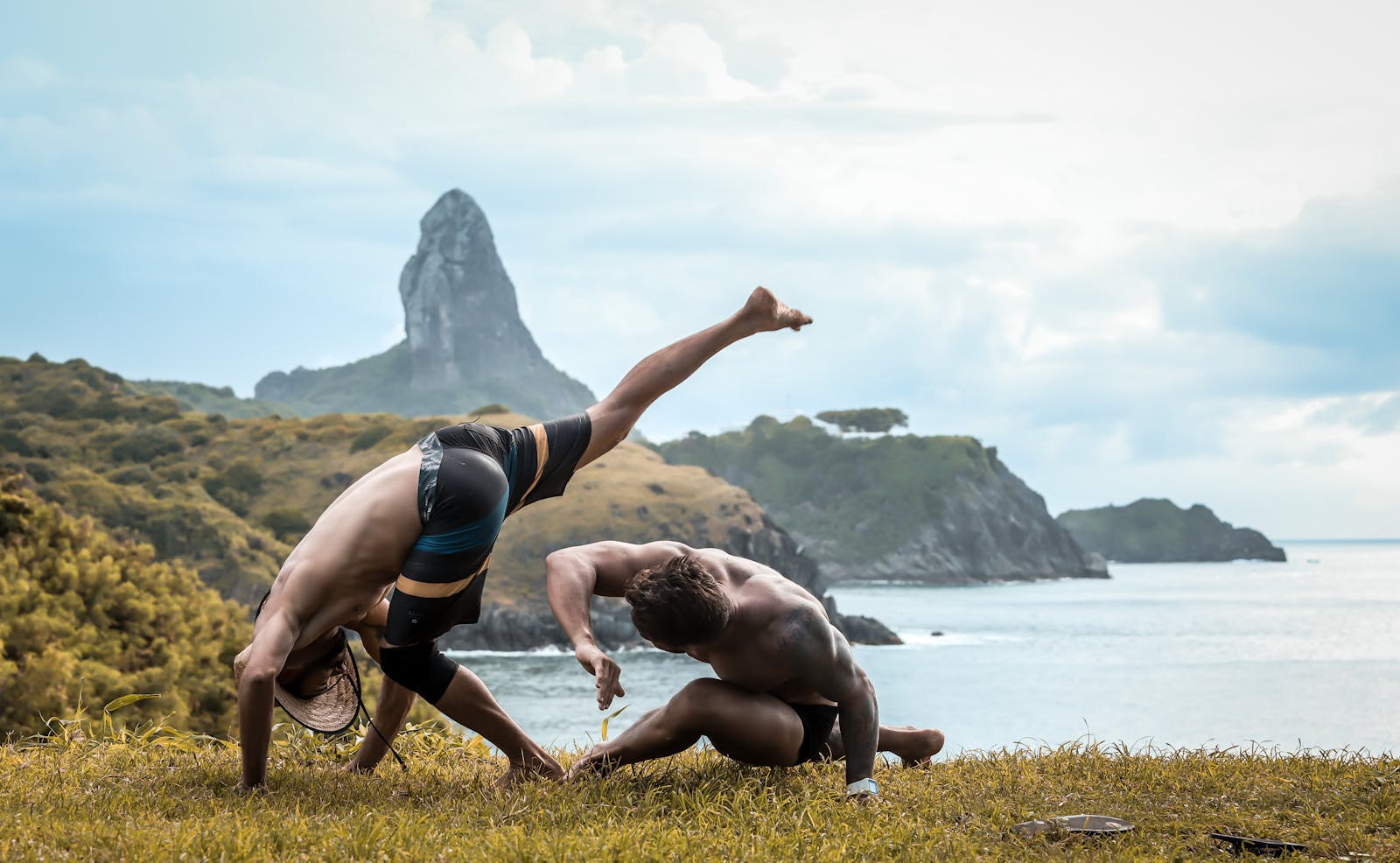Capoeira, a Brazilian martial art that combines elements of dance, acrobatics, and music, has gained popularity worldwide for its unique blend of culture, athleticism, and fluid movement. Capoeira’s roots are deeply intertwined with Afro-Brazilian history, originally developed by enslaved Africans in Brazil as a way to disguise their self-defense techniques as dance. Today, people are drawn to capoeira for various reasons, including self-expression, community, physical fitness, and, in some cases, self-defense.
This article explores whether capoeira is good for self-defense and physical fitness, providing an in-depth look at its effectiveness, benefits, and limitations in both areas.
1. Capoeira for Self-Defense
1.1 Fluid Movements and Unpredictability
One of capoeira’s defining characteristics is its fluid, continuous movements. Practitioners, or capoeiristas, move rhythmically, often to the beat of traditional music, making it difficult for opponents to predict their next moves. Capoeira emphasizes agility, quick transitions, and spinning kicks, all of which can make it an effective martial art in certain self-defense situations.
- Unpredictability: Capoeira’s movements are unconventional compared to traditional martial arts like karate or boxing. Its use of evasive techniques, such as dodges, spins, and acrobatic flips, can confuse an attacker, making it hard for them to anticipate your strikes or defenses.
- Speed and Agility: Capoeira requires fast reflexes and precise timing. These attributes can be advantageous in a self-defense scenario, where quick decision-making and movement are essential for avoiding an attacker’s strikes.
1.2 Evasive Techniques
Capoeira is known for its defensive maneuvers, particularly its use of evasion rather than direct blocking. Capoeiristas practice avoiding strikes by moving their bodies out of the way, using rolls, flips, and other acrobatic movements. This makes capoeira a defensive martial art at its core, as it focuses on avoiding harm rather than absorbing blows.
- Evasion over Blocking: Instead of standing still and blocking punches or kicks, capoeiristas will often duck, sidestep, or cartwheel out of the way, keeping themselves moving. This can help prevent injuries during a physical confrontation by making it harder for an attacker to land a hit.
- Counter-Attacks: Capoeira’s fast-paced nature allows practitioners to quickly transition from defensive moves to counter-attacks. Spinning kicks, low sweeps, and headbutts are often used in counter-attacks after evading an opponent’s strike.
1.3 Capoeira in Real-World Self-Defense Scenarios
While capoeira’s fluid movements and evasive techniques can be useful in self-defense, there are limitations to how effective the art can be in real-world situations. Capoeira is more suited for stand-up fighting and may not be as effective in close-quarters combat, grappling, or against multiple attackers. Additionally, many of capoeira’s acrobatic movements, while visually impressive, may leave the practitioner vulnerable to counterattacks if not executed with precision.
- Strengths in Self-Defense: Capoeira’s unpredictability and emphasis on mobility can be advantageous in one-on-one confrontations, where surprise, agility, and speed are key. It is particularly useful in situations where the defender can maintain a safe distance from their attacker and use evasive maneuvers effectively.
- Limitations in Self-Defense: In situations where an attacker is too close or has grabbed the practitioner, capoeira’s evasive techniques may not be as effective. Unlike other martial arts that focus on grappling or submission techniques (such as Brazilian Jiu-Jitsu), capoeira lacks training in ground fighting and close combat. This could make it less effective in situations where the defender is pinned or cannot evade easily.
1.4 Integration with Other Martial Arts
Many practitioners of capoeira find that integrating it with other martial arts can improve its effectiveness for self-defense. Combining capoeira with disciplines that emphasize grappling, submissions, or joint locks, such as Brazilian Jiu-Jitsu or Muay Thai, can fill the gaps in close-quarters defense. Some modern capoeira schools have also incorporated elements from other martial arts to create a more well-rounded system for self-defense.
Conclusion: Capoeira for Self-Defense
Capoeira can be useful for self-defense, especially in situations that require quick evasions, agility, and unpredictability. Its emphasis on movement and fluidity can help practitioners avoid strikes and counterattack effectively. However, it may not be as effective in grappling or close-quarters situations, so combining it with other martial arts could enhance its practicality for real-world self-defense scenarios.
2. Capoeira for Physical Fitness
2.1 Full-Body Workout
Capoeira is widely regarded as an excellent full-body workout. The practice involves a combination of martial arts techniques, acrobatic movements, and rhythmic dance, all of which engage multiple muscle groups at once. Capoeiristas use their upper body, core, and lower body simultaneously during movements, resulting in a highly dynamic workout that builds strength, endurance, and flexibility.
- Strength: Many capoeira movements, such as cartwheels, handstands, and kicks, require significant upper body and core strength. Regular practice helps develop muscle tone and functional strength, particularly in the arms, shoulders, and abdominal muscles.
- Endurance: Capoeira is often practiced in long sessions, sometimes referred to as “jogos,” which can last for several minutes without rest. This builds cardiovascular endurance, as the body needs to maintain stamina throughout these sessions.
- Flexibility: Capoeira’s high kicks, spinning techniques, and acrobatic moves demand a high degree of flexibility, particularly in the hips, legs, and back. Practicing capoeira regularly can improve joint mobility and range of motion.
2.2 Cardiovascular Fitness
Capoeira is a highly aerobic activity, with movements that keep the heart rate elevated for extended periods. Whether performing fast-paced kicks or engaging in evasive footwork, capoeira challenges cardiovascular endurance, making it an excellent way to improve heart health and burn calories.
- Aerobic Conditioning: The continuous movement and combination of high-intensity bursts make capoeira an excellent cardiovascular workout. It’s comparable to high-intensity interval training (HIIT), where short periods of intense activity are followed by brief recovery periods.
- Fat Burning: Due to the aerobic nature of capoeira, it helps burn calories and reduce body fat. The high-energy movements engage large muscle groups, leading to increased calorie expenditure during and after training.
2.3 Balance and Coordination
Capoeira’s movements are designed to improve balance, agility, and coordination. The constant shifting of weight from one foot to another, along with the use of acrobatic movements like handstands and flips, helps practitioners develop better body control. This improvement in balance and coordination can translate into better performance in other physical activities and sports.
- Balance: Many capoeira techniques involve maintaining balance while performing complex movements, such as executing kicks while rotating the body or transitioning between high and low stances. This helps improve overall balance and stability.
- Coordination: Capoeira requires practitioners to synchronize their movements with the rhythm of the music and the actions of their opponent. This enhances hand-eye coordination, footwork, and spatial awareness, which are beneficial in many aspects of physical fitness.
2.4 Mental and Emotional Benefits
In addition to its physical benefits, capoeira offers mental and emotional advantages. The rhythmic, flowing nature of the art, along with the incorporation of music and singing, creates a meditative, almost trance-like state for practitioners. This helps reduce stress, improve focus, and boost mood.
- Stress Relief: The rhythmic, dance-like movements, combined with capoeira’s musical elements, can help reduce stress and anxiety. Capoeira is often practiced in groups, creating a supportive community environment that promotes emotional well-being.
- Mental Focus: Capoeira requires quick decision-making, spatial awareness, and strategic thinking, which help improve mental clarity and focus. The constant movement and interaction with a partner enhance cognitive function and reflexes.
- Self-Expression: Capoeira is an art form that encourages individuality and creativity. Practitioners can express themselves through their movements, contributing to a sense of personal freedom and confidence.
Conclusion: Capoeira for Physical Fitness
Capoeira is an exceptional form of physical fitness that offers a full-body workout, cardiovascular conditioning, improved balance, and enhanced flexibility. Its dynamic movements engage multiple muscle groups, helping practitioners develop strength, endurance, and agility. Moreover, capoeira promotes mental and emotional well-being through its rhythmic nature, social environment, and opportunities for self-expression. Whether practiced as a martial art or purely for fitness, capoeira provides a holistic approach to physical and mental health.
Final Thoughts
Capoeira is both an art and a martial discipline, offering benefits for both self-defense and physical fitness. While it may have some limitations in self-defense scenarios that involve close-quarters combat or grappling, its emphasis on evasion, unpredictability, and agility can make it effective in certain situations. As a fitness regimen, capoeira is unparalleled in its ability to provide a full-body workout, improve cardiovascular health, and enhance balance and coordination.
Whether you’re looking to get fit, learn self-defense, or explore a unique cultural practice, capoeira is a dynamic and rewarding martial art that can offer both physical and mental benefits.




